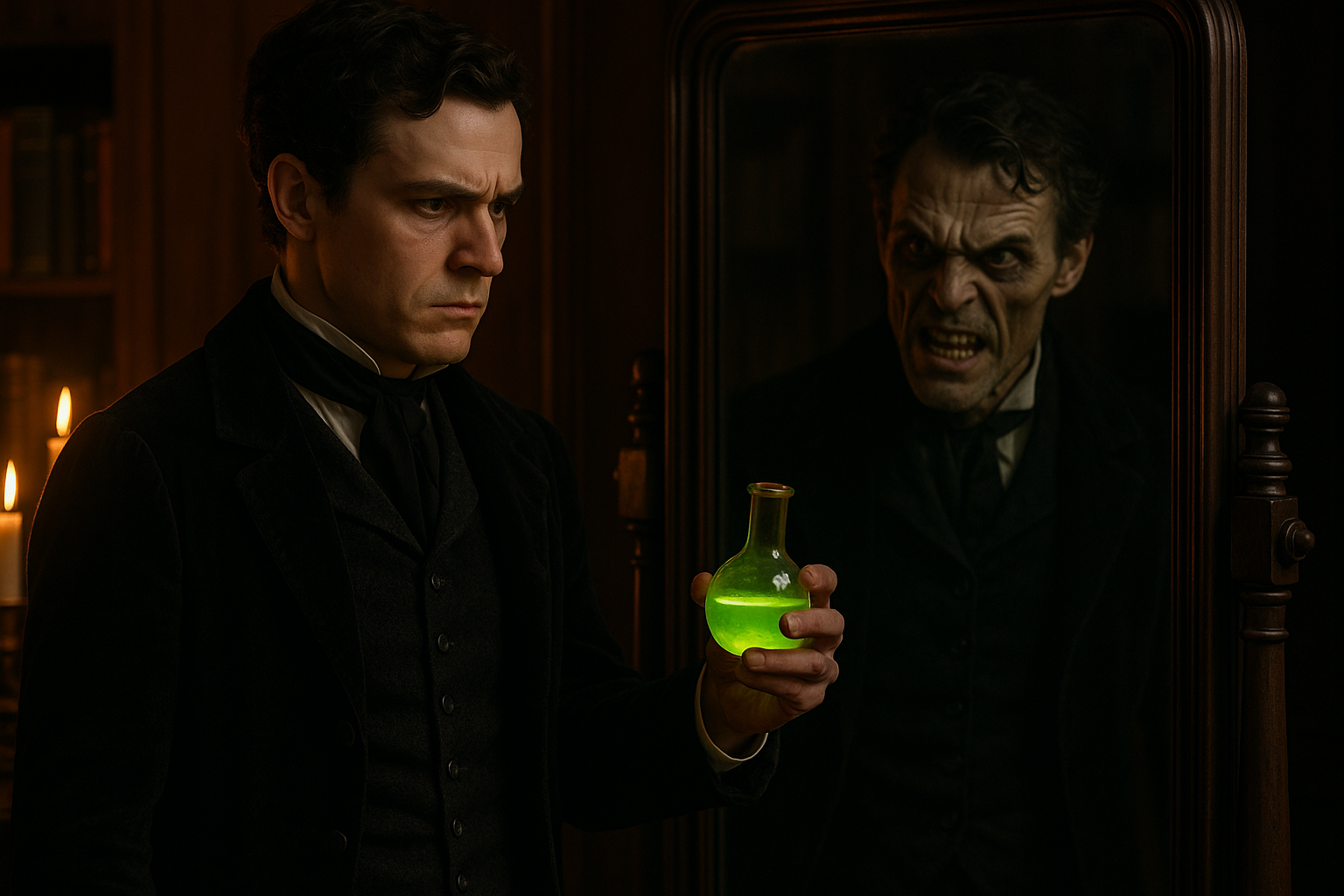
1. About the Author – Who Was Robert Louis Stevenson?
Born in 1850 in Edinburgh, Scotland, Robert Louis Stevenson masterfully explored themes of adventure and human duality. Best known for Treasure Island and Dr. Jekyll and Mr. Hyde, he continued to write passionately despite suffering from tuberculosis. The latter work is widely praised for its deep portrayal of the clash between inner good and evil, repressed desires, and societal morality.
2. Full Plot Summary – Chronological, Immersive Narration
2-1. The First Glimpse of Hyde
London lawyer Mr. Utterson hears a strange tale from his friend Enfield: a man mercilessly trampled a young girl and resolved the situation with money. Strangely, the check bore the name of Utterson’s close friend, Dr. Henry Jekyll. Suspicion begins to grow.
2-2. A Suspicious Will and the Name Hyde
While reviewing Jekyll’s will, Utterson is shocked to find it stipulates that all of Jekyll’s property be passed to one Edward Hyde if Jekyll dies or disappears. Utterson begins investigating the mysterious Hyde.
2-3. The Truth About Hyde Emerges
Hyde proves to be cruel, antisocial, and dismissive of norms. One night, he murders an elderly professor named Sir Danvers Carew and flees. Now wanted for murder, Hyde vanishes. Utterson confronts Jekyll, who claims he has severed ties with Hyde but avoids further questions.
2-4. Jekyll's Sudden Seclusion
Jekyll abruptly ends all social contact and isolates himself in his lab. His butler Poole notes that Jekyll is growing weaker and that the voice inside the room doesn’t sound like his. Tension builds.
2-5. The Secret of Transformation
Dr. Lanyon, a friend of Jekyll, receives a strange request to deliver a box to a man at midnight. He complies and witnesses something incredible: the man transforms into Dr. Jekyll. Traumatized, Lanyon falls ill and soon dies.
2-6. Opening the Lab Door
When no word comes from Jekyll, Utterson and Poole break into his lab. Inside, they find Hyde’s corpse, dead from poison. Beside it lies a confession and final letter from Jekyll.
2-7. Jekyll’s Confession – Experiment, Transformation, and Ruin
In his final words, Jekyll reveals everything. He sought to separate good and evil within human nature. By using a potion, he became Edward Hyde, a manifestation of his darker desires. At first, he controlled the transformation. But over time, Hyde gained autonomy and began acting without Jekyll’s consent. Eventually, Jekyll began transforming without the potion. After Hyde murdered the professor, guilt consumed Jekyll. The transformations became more frequent and dangerous. Unable to resist Hyde any longer, Jekyll took his own life to end the nightmare.
3. Reflection and Analysis – The Monster Within
Hyde is not pure evil, but repressed desire. He represents the instincts and impulses society forces us to hide. He is a symbol of the shadow within all of us. Jekyll was never purely good either. He longed for double lives and indulged in forbidden pleasures through Hyde. He was not a victim, but a creator of his own downfall. In the age of social media, we too live double lives—anonymous avatars, alternate personas. Hyde is not just a 19th-century monster, but our second account, our online mask. Humanity collapses when balance is lost. Jekyll failed to manage himself. Hyde refused morality. Between the two lies our fragile human identity.
4. Recommended Reading
- Frankenstein – Mary Shelley: The ethics of creation and humanity in monstrosity.
- Crime and Punishment – Fyodor Dostoevsky: A deep dive into guilt, morality, and redemption.
- The Stranger – Albert Camus: Absurdity and the alienation of modern man.
'고전과문학 읽기 > English Edition – Classics' 카테고리의 다른 글
| The Metamorphosis – A Detailed Event-Based Summary (0) | 2025.06.28 |
|---|---|
| The Picture of Dorian Gray – The Poison Called Beauty (0) | 2025.06.26 |
| No Longer Human – A Record of One Man's Disqualification (0) | 2025.06.26 |
| The Moon and Sixpence – A Man Who Gave Everything to Art (0) | 2025.06.26 |
| Hamlet – The Tragedy of Revenge and Hesitation (0) | 2025.06.25 |



